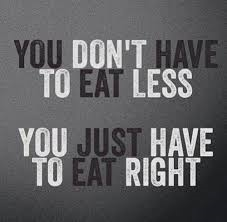What’s a Macro to You? (Part 2)
The Fluff Behind It All
Every person on the planet has this perception of carbs being absolute evil and that you MUST stay away from them at all costs! However, fats kind of get that same wrap as well. So what is one to do? Only eat protein?
Of course not! Carbs and fats have their place in your life but just like with anything there is a time and a place for them.
Carbohydrates
Carbs in moderation are beneficial to the body and is what your body uses as an energy source. However, too much of a good thing isn’t necessarily a better thing… at all. Carbohydrates can be categorized into two different groups: simple, and complex.
Simple carbohydrates can be defined as carbohydrates that have one or two sugar molecules… also known as monosaccharides and disaccharides.
“Mono”-saccharides meaning “one” sugar molecule include fructose, galactose, and glucose.
“Di”-saccharides meaning “two” sugar molecules include lactose, maltose, and sucrose. These “simple” carbohydrates will typically breakdown quicker in your body allowing for quick use.
Complex carbohydrates can be defined as carbohydrates that have three or more sugar molecules… such as polysaccharides or starches. These carbohydrates take longer to breakdown into sugar for the body to make use of.
Contrary to what you may have been told or have believed up to this point… simple and complex doesn’t necessarily distinguish if it is good or bad. There is something a little more detailed to look at called the Glycemic Index (GI).
The Glycemic Index is designed to tell you which foods break down at what speed. The smaller the number on the GI scale for the food, the slower it takes to digest causing a slower insulin response, versus the higher the number of the food on the GI scale the quicker it digests, the more insulin your body releases.
An abundance of insulin being released in the body at a given point is not a good thing and can make you even hungrier, can negatively affect fat loss, and can even lead to diabetes over time.
Fats
We can divide fats into four main categories: monounsaturated fat, polyunsaturated fat, Tran’s fat, and saturated fat. The first two listed (monounsaturated, and polyunsaturated) can be labeled as the “good fats.” They are good for your cholesterol, heart, and overall health.
You can find them in foods such as:
•Olive, canola, sunflower, peanut, soybean, corn, safflower, sesame oils
•Avocados
•Olives
•Walnuts
•Flaxseed
•Peanut Butter
•Nuts
•Fatty Fish (salmon, tuna, herring, trout, etc.)
The second two (saturated, and Trans fat) are considered to be “bad fats.” They can elevate cholesterol and increase risk of disease.
These bad fats can be found in the following foods:
•Red meats
•Whole fat dairy products
•Butter
•Cheese
•Ice Cream
•Pastries, cookies, doughnuts, muffins, cakes
•Fried foods
•Candy bars
An easy way to try to remember which fats are good or bad is that the bad fats tend to be solid at room temperature and the good fats are liquid at room temperature.
So now that we know what a macro is and how they aren’t equal to each other I guess that first question should be “What should my daily macro numbers be?” Instead of “how many calories do I need daily?”
Tie all this information together at Derek’s next free nutrition seminar on October 17th at 7:15pm. Come get all of your questions answered!
Make food your daily ally, not your enemy.
 To demand the most of your body, you must know your body!
To demand the most of your body, you must know your body!
In Fitness and Health,
Richard Berrian
Personal Trainer
#gunslikerich




